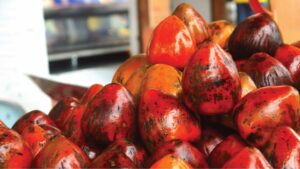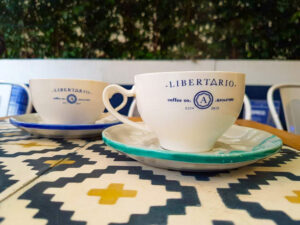I looked up at the sky. I should have known better. When I left the house it was sunny, and just half an hour later the clouds had gathered quick and dark above me. But that’s typical of Bogota and its weather. During the rainy season, 15 minutes of sun and 15 minutes of rain can alternate all day long.
But I was promised that the street food tour by La Mesa Food Tours would go on rain or shine, so I had my umbrella in hand as I walked through the Parque de los Periodistas in Bogota’s La Candelaria neighborhood. Mt. Monserrate loomed over me, it’s head in the dark clouds.
I saw Margarita, my tour guide for the morning, and she smiled at me. But as I walked up to her, what caught my attention most was what she had in her hand. An enormous plastic cup with long yellow strips that twirled around themselves. Mango biche. Green (as in unripe) mangoes are cut into thin, long strips and dosed with salt and pepper and fresh squeezed lime juice. A healthy treat.
As we dig into the tangled strips of fruit, Margarita told us Colombians also like it with sweetened condensed milk oraguardiente and it’s a common treat along the coast of Colombia. I’d certainly had it often when I needed a snack, buying it from tiny green mango-shaped carts in parks and on heavily transited streets.

Why a food education?
But hold on a minute. Why was I, a food writer in Colombia, doing a food tour? Didn’t I already know all about food in Colombia?
Well, I do know quite a bit. But food tours are a great way to learn all about what you don’t know. Also, readers often write in to Flavors of Bogota to ask how they can get a true Colombian food experience – without any negative side effects. I need to know what to recommend.
You will see free tours around the city, but be prepared to be in groups of up to 30 people where you might not even catch a glimpse of your tour guide. I prefer small tours like this one, where a maximum of eight people makes the experience feel more like an extended family than the whole neighborhood tagging along.
The journey
From there we started out, walking up slight hills and narrow cobblestone streets. Short bursts of history lessons came in between mouthfuls of local foods. We learned about brave women that defied a firing squad and heroes of what was then a new nation.
We went from an arepa stand to a chocolate experience to fruits to restaurants. Cultural tidbits got mixed in with culinary ones as we admired street art that tells the history of a country and a diverse people. We saw Bogota’s past unfold in pictures dating back decades as we dug into soups that mix all the cultural backgrounds of Colombians. Frankly, I have never tried so many Colombian treats in one day – or even in one month – as I did on this street food tour.

We tried what is sometimes called “indigenous beer” that’s common throughout the region (my tip is to not smell it first – I assure you that the taste is pleasant). I was surprised by the amount of vegetarian and gluten free foods on the tour (although there were few vegan options).
At a local market we tried fruit juices with mixes I’d never heard of. If you’ve spent any time in Colombia or read enough about the country, you’ve heard about the fruit. Lulo, curuba, feijoa, pitaya, uchuva. All those exotic names – well, here’s your chance to put a face to them all and try them in just one sitting, as fruit or made into juice.
And the rain did come down. At times in an irritating mist, at times hard enough that we were glad we were in a cozy restaurant. But it never interfered with the tour.
And perhaps the rain and cold in Bogota are as culturally important as the food. It’s influenced the high boots and leather jackets popular in every social class as well as the knitted scarves and gloves that street vendors sell.
Similarly, much of Bogota’s culinary traditions were formed by the chilly temperatures people have been trying to beat for centuries. So in rain or shine, now you know which street food tour will give you an education in Colombian culinary traditions.
This story originally appeared on the website Flavors of Bogotá by Karen Attman. Be sure to check out her website to get all the latest culinary news from Colombia’s capital city.
SOURCE: http://www.flavorsofbogota.com/education-street-food-tour/




